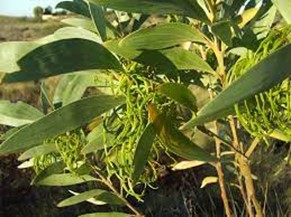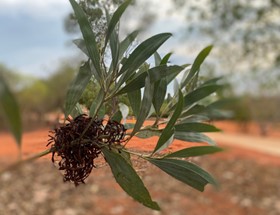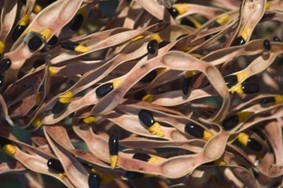Soap Wattle
Acacia colei
Lirringgin (Yawuru/Karajarri)
Flowering and Fruiting: Seeds Barrgana to Wirlburu between September and October

Lirringgin is a widespread species of northern Australia, occuring in WA, NT and Queensland. It’s a perennial open shrub that grows up to 5 m tall, or is found sometimes as a tree up to heights of around 9 m (30 ft) usually with a spreading habit.
It is known in English as Soap or Cole’s Wattle or Soap Bush. It is also sometimes known as a Candelabra Wattle. The plant is known as soap wattle because Its sticky and unripe green seed pods can be crushed up, moistened and rubbed between palms to produce a soap-like lather which removes dirt and was used to clean hands.
When dry and brown, the masses of curly brown pods yield a lot of small black seeds with tiny yellow tips. The seeds are edible and have a pleasant nutty flavour.

When green, the seeds were roasted in the pods. Traditionally, when dry and brown the seeds are winnowed from the pods and warmed or cooked on the fire, and then crushed, mixed with water and used for small dampers. More contemporary uses of the seeds are in biscuits, cakes or even in wattleseed coffee. Eating the seeds raw is not advised.
Popularity and value of wattleseed is growing and some Kimberley groups are developing harvests and sales for commercial purposes.

For more information SKIPAs (Society for Kimberley Indigenous Plants and Animals)
